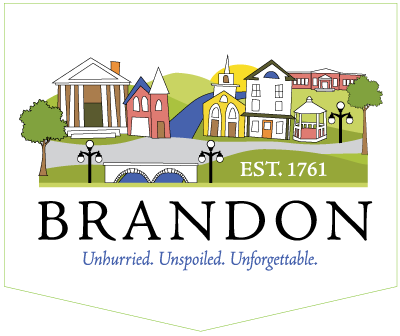History, Architecture, Downtown
Chartered in 1761, Brandon is a study in early American architecture and Vermont history.
When the first settlers came to the area in the mid-1770s, they established the village of Neshobe. The area was rich in natural resources with excellent farmland along the rivers and abundant supplies of timber and minerals. The Town grew and flourished during the 1800s with several industries relying on the key resources of waterpower, iron ore and marble. The coming of the railroad in 1849 enabled the manufacture and shipping of iron-based products such as the Howe scale, as well as Brandon paints, wood products and marble.

During its century of rapid growth, Brandon Village evolved a unique village plan. Churches were built on either side of the Neshobe River, each with its own green laid out at a bend in the road. In the ensuing decades, government, commerce and prominent individuals developed commercial streets at the core which radiated out from the greens lined with residences leading to farms, mines and quarries in the Town. Pearl and Park Streets were laid out to be suitable for militia training, resulting in broad, tree-shaded streets with deep front yards.
Most of Brandon's architecture has distinctive characteristics from stylistic periods such as Federal, Greek Revival, and Victorian. Some buildings include distinguishing elements and stylistically can be called Gothic Revival, Italianate, or Second Empire. However, most early houses and other buildings were simple farmhouses to which were added features that, by their character, can be assigned to a period or span of years. Brandon's 19th century churches also show a variety of different types of architecture.
Famed 19th century statesman Stephen A. Douglas was born in Brandon and his birthplace is now the Brandon Museum as well as the town's Visitor Center. Thomas Davenport, who is said to have invented the electric motor although he never achieved fame for his invention and died penniless, also was born and lived in Brandon.
As the early industries began to decline, dairying, stockbreeding and tourism became increasingly important and ensured the vitality of Brandon in the 20th century.
Today Brandon is a thriving, diverse community offering a full range of services for its citizens. Several industries, a variety of shops and services provide many opportunities for town residents and surrounding communities. Brandon's historic downtown with its entire core of 243 buildings is listed on the National Register of Historic Places.
Our downtown is a great place to stroll and admire, begin a self-guided walking tour, or check in to Geotourist to hear from our business community.
BUT the walking tour is pre-segment 6 so some adjustments are needed. Brandon's Self-Guided Historic Walking Tour is available here as a PDF download.





